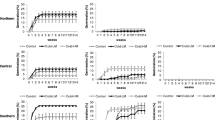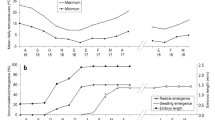Abstract
Temperature dependencies of sprouting and germination were compared for subterranean perennating organs and seeds of ten closely related species of the genusDioscorea (Dioscoreaceae), a group of monocotyledonous summer perennials which are distributed from the tropics to the subarctic. The species used wereD. nipponica Makino,D. tokoro Makino,D. japonica Thunb.,D. tenuipes Franch. et Savat.,D. septemloba Thunb.,D. quinqueloba Thunb.,D. izuensis Akahori,D. bulbifera L. f.spontanea (Makino) Makino et Nemoto,D. pentaphylla. L. andD. alata L.; they are distributed from cold northern areas to warmer southern areas approximately in this order in and around Japan. Bulbil sprouting was also studied in those forming bulbils.
Subterranean organs of the tropical species sprouted faster without any prior temperature treatment, whereas those of species from the more northern areas sprouted after prechilling. Northern species required longer, periods of prechilling for sprouting. On the other hand, with seeds or bulbils, the southern species required longer periods of prior temperature treatment for dormancy breaking. This difference in the length of dormant periods between seeds or bulbils and subterranean organs among the ten species may be related to their size and position of shedding; seeds or bulbils are small and are shed on the ground surface, whereas subterranean organs are large and are located below the surface.
It is important to determine in other perennials whether the above relation between dormant features of seeds or bulbils and subterranean organs are common properties or not.
Similar content being viewed by others
References
Ayensu, E. S. 1972. DioscorealesIn: C.R. Metcalfe, ed., Anatomy of MonocotyledonsVI: 1–182. Oxford Univ. Press, London.
Burkill, I.H. 1954. Dioscoreaceae.In: C.G.G.J. Van Steenis, ed., Flora Malesiana. Ser. 1,4: 293–335. P. Noordhoff Ltd., Groningen.
—. 1960. The organography and evolution of Dioscoreaceae, the family of yams. J. Linn. Soc., Bot.56: 319–412.
Hatusima, S. 1971. Flora of Ryukyus. Okinawa Seibutu Kyoiku Kenkyukai. Naha (in Japanese).
Iwao, T. 1980. Seed germination of some JapaneseDioscorea species. Shushi Seitai12: 12–14 (in Japanese).
Masaki, S. 1974. Konchu no Seikatsushi to Shinka. Chuokoronsha, Tokyo (in Japanese).
Matumura, M. 1969. Some observations on germinability and heading behavior of low- and up-land types ofAlopecurus collected from various localities of Japan. (Genecological studies of foxtail grass in Japan). Res. Bull. Fac. Agr. Gifu Univ.28: 252–266 (in Japanese with English summary).
Ohwi, J. 1953. Flora of Japan. Shibundo, Tokyo.
Okagami, N. 1978. Dormancy inDioscorea: Sprouting promotion by inhibitors of protein synthesis in bulbils and rhizomes. Plant Cell Physiol.19: 221–227.
— 1979. Dormancy in bulbils of several herbaceous plants: Effects of photoperiod, light, temperature, oxygen and gibberellic acid. Bot. Mag. Tokyo92: 39–58.
— andM. Kawai. 1977. Dormancy inDioscorea: Gibberellin-induced inhibition or promotion in seed germination ofD. tokoro andD. tenuipes in relation to light quality. Plant Physiol.60: 360–362.
—and—. 1982. Dormancy inDioscorea: Differences of temperature responses in seed germination among six Japanese species. Bot. Mag. Tokyo95: 155–166.
—and—. 1983. Dormancy inDioscorea: Range, duration and timing of high-temperature treatment in germination inhibition ofD. tokoro seeds. Plant Cell Physiol.24: 509–515.
— andM. Nagao. 1971. Gibberellin-induced dormancy in bulbils ofDioscorea. Planta101: 91–94.
— andN. Tanno. 1977. Dormancy inDioscorea: Generality of gibberellin-induced dormancy in asexual dormant organs. Plant Cell Physiol.18: 309–316.
Pianka E.R. 1978. Evolutionary Ecology, 2 ed. Harper and Row, New York.
Prain, D. andI.H. Burkill. 1936. An account of the genusDioscorea in the East. Ann. Roy. Bot. Grdns, Culcutta14: 1–528.
Purseglobe, J.W. 1975. Tropical crops. Monocotyledons. Longman, London.
Sayers, R.L. andR.T. Ward. 1966. Germination responses in alpine species. Bot. Gaz.127: 11–16.
Shibata, O. andT. Arai. 1970. Seed germination inPolygonum reynoutria Makino grown at different altitudes. Jap. J. Ecol.20: 9–13.
Thompson, P.A. 1970. Characterization of the germination responses to temperature of species and ecotypes Nature225: 827–831.
Toy, S.J. andB.C. Willinghan. 1966. Effect of temperature on seed germination of ten species and varieties ofLimnanthes. Econ. Bot.19: 71–75.
Zimmerman, C.A. 1977. A comparison of breeding systems and seeds physiologies in three species ofPortulaca L. Ecology58: 860–868.
Author information
Authors and Affiliations
Rights and permissions
About this article
Cite this article
Okagami, N. Dormancy inDioscorea: Different temperature adaptation of seeds, bulbils and subterranean organs in relation to north-south distribution. Bot Mag Tokyo 99, 15–27 (1986). https://doi.org/10.1007/BF02488619
Received:
Issue Date:
DOI: https://doi.org/10.1007/BF02488619




